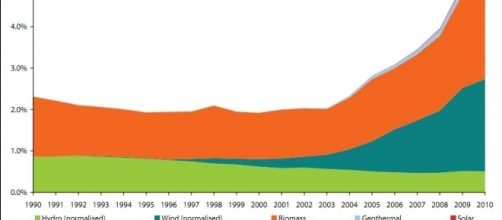The UK is lacking in leadership on the issues that need to be tackled including an Energy policy that stretches beyond the next general election in 2020. The trend of high carbon investment over low carbon investment has reversed, for the first time since 2012. However, this is down to a decrease in public sector spending on high carbon assets rather than a change in government policy.
A report by the Green Alliance in December highlights the UK’s infrastructure pipeline. The government’s infrastructure pipeline sets out its view on large investments that are likely to be made throughout parliament and beyond.
The Green Alliance analysed the latest iteration of this.
A potential cliff edge
The overall picture contrasts drastically to the details and in the past 6 months, spending on renewables has dropped by £1.1 billion. This isn’t down to falling costs of renewables but due to shrinking of pipeline projects.
There could be a potential cliff edge between 2017-2020, where investment is due to fall by approximately 95% and this needs to be avoided if the UK is to meet the targets set out by the Paris Climate Agreement. Airport spending has risen by approximately 8.5% but this is largely down to new spending at Stansted and the expansion of City Airport.
Although investment in renewables has dropped by the government they have cut £2 billion from the cost of Nuclear decommissioning, and this frees the Department of Business, Energy and Industrial Strategy’s (BEIS) budget.
This could potentially free up spending on low carbon heat and energy efficiency rather than legacy clean-up costs, as was the case when the Green Alliance analysed the Department of Energy and Climate Change’s (DECC) budget. This accounted for 80% of the DECC’s budget which meant that savings in this area were vital.
The balance of spending
Excluding HS2, low carbon transport spending has risen by £2.3 billion since spring 2016, although the Green Alliance point out that this is more down to local authorities choosing to spend transport funds on bus and light rail, as well as cycling and walking.
Whilst spending on roads has broadly stayed the same, HS2’s has risen by £1.1 billion which reflects higher than expected costs.
The balance of private sector spending is rapidly moving from high carbon to low carbon infrastructure, but it is the public sector that is failing.
The government have moved to increase spending in high carbon infrastructure, but this is moving slowly. Currently the peak of low carbon investment from the private sector will be this year before falling back, but this is mostly down to a lack of low carbon policy in the early 2020s.
Policy environment
The government pipeline does show that investment into low carbon assets can match divestment from high carbon ones, with the right policy environment. With the forthcoming Emissions Reduction Plan, the challenge will be for the government to deliver the right plan to ensure that low carbon investment keeps up by the end of this parliament and into the 2020s.
The Green Alliance have stated that the gaps are in “energy, heat, and transport markets and proposed actions for government to take to meet its climate targets.”
Whether Theresa May will plug those gaps or continue the potentially destructive path is unclear, but if she continues then the UK’s energy infrastructure will be inherently flawed and broken long after we should have moved onto renewable energy sources. This would weaken us environmentally, with sustainability issues and will cause economic fragility.

